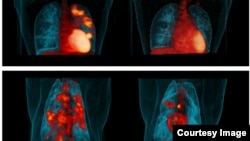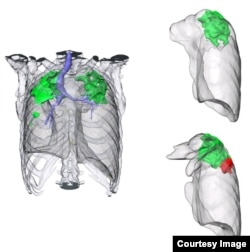Tuberculosis drugs have their shortcomings. They do not work very fast, and drug-resistant strains of TB keep emerging. Now, scientists have demonstrated how medical imaging technology can help develop better drugs to treat tuberculosis.
In its most recent report, the World Health Organization says nine million people developed TB last year, and 1.5 million people died from the disease. Most cases were in the Asia-Pacific region, but tuberculosis is deadliest in Africa, which had the highest proportion of cases and deaths.
Treating a tuberculosis patient involves multiple drugs, typically given over a course of six months. That is a lot of pills, and because people often feel better before the treatment is over, they stop taking their medicine.
But an incomplete course of treatment can lead to drug-resistant TB, so researchers are trying to develop new drugs that do not need to be taken for so long.
Clifton E. Barry III, PhD, of the U.S. National Institute of Allergy and Infectious Diseases, is the lead author of a report in the journal Science Translational Medicine about their efforts.
“And what we are trying to do... is to build a new methodology for determining how long you need to be treated with different combinations and shorten that course of therapy,” he explained in a telephone interview.
Borrowing from techniques used by cancer-drug researchers, Barry and his team used two advanced imaging techniques, PET and CT scans, that can look into the body of people participating in drug trials and see - literally see - whether a particular treatment being tested is working against the tuberculosis infection.
“What we are trying to do is understand what the healing response looks like in people so that we can categorize how good a particular drug regimen is at inducing that healing response,” he said.
Now that he has shown that medical imaging tests can be used to see if a potential tuberculosis drug is working, Barry says he and his colleagues are launching a study in South Africa to directly compare this new way of evaluating TB drugs with the old methods . And he says there is growing interest in using PET and CT scans to help develop drugs to treat other infectious diseases.

